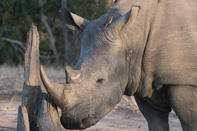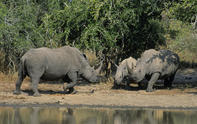Sights and Smells
To demarcate his territory a bull white rhino employs a number of visual and olfactory signals. Patrols along well-used paths take place to establish and reinforce boundaries. While patrolling, the bull will urine-spray backwards onto bushes and other conspicuous objects.

Every 30 m or so, the bull will also create visual scrape-markings with his feet that simultaneously become impregnated with his urine. As he continues his patrol, the scent is laid in the form of an olfactory (smell) trail wherever his feet touch. This is also achieved by kicking his dung with his hind feet after defecating.
Intermittently along the territory boundaries, large accumulations of dung, known as middens, are formed and constantly added to by the bull and even by his neighbour. Cows, and subordinate bulls, will deposit their dung on a bull’s midden as and when they pass but refrain from breaking up their dung in the manner of the territorial bull.
These sites provide important information to the territory owners, such as when and who has passed through his turf.
White Rhino Mating

Rhinos must surely hold the record for the most protracted mating. Copulation lasts a full 30 minutes achieved in only one mounting. Bulls find cows in oestrus by picking up hormones in their urine that they leave behind when traversing a bull’s territory.
Rhino’s practice flehmen to check for the steroid hormones in the cow’s urine. They do this by pumping airborne particles into the Organ of Jacobsen on the roof of the mouth by means of a facial grimace that turns up the lips. Once a cow has been identified as being on heat, the bull goes to great lengths to prevent her from leaving his turf and chases off any other males in the vicinity quite vociferously with snorts and shrieks.
The cow may not be a willing captive and often the bull will be aggressively rejected. The male, however, shows great persistence in herding the female, chasing her, squealing and even clashing horns. Courtship can last 14 to 20 days and the pair will remain in each other’s company for up to six days after mating.
By Megan Emmett